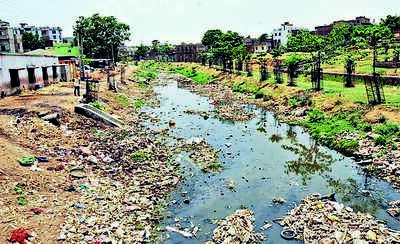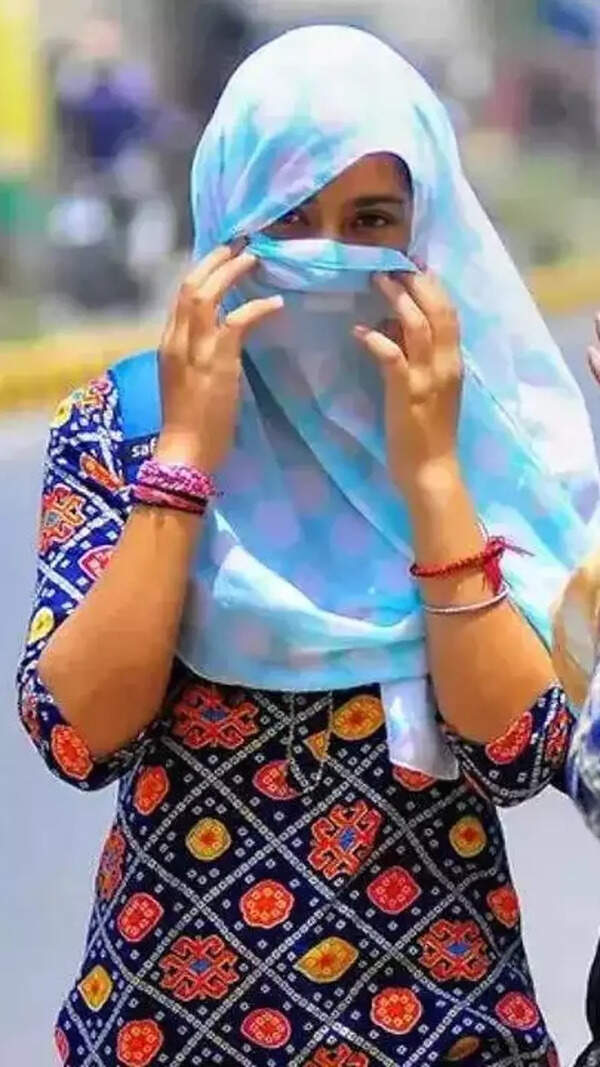- News
- City News
- ranchi News
- Harmu river only a drain in Ranchi now, water turns black
Trending Topics
Harmu river only a drain in Ranchi now, water turns black

RANCHI: Devesh Kumar Pandey’s family settled at Ketaribagan in Ranchi’s Chutia locality over 30 years ago. Growing up, Pandey accompanied his parents, siblings, and neighbours to the confluence of Harmu and Swarnarekha rivers to offer prayers during the annual Chhath festival. But the family has stopped visiting Harmu for over a decade now, as the river water turned black and began emitting a pungent smell.
In his youth, Manoj Sharan watched the Harmu waters swell during the monsoon months. “The river was more than 20-metre wide during the other times of the year. The water was clean and used by locals for household chores and drinking too. The sand from the river basin was mined and transported in bullock carts by Ranchi residents to construct homes and other buildings. Today, the river has turned into a drain and its water is polluted due to the untreated discharge from households across the city,” he said.
Harmu river, once the lifeline of Ranchi, is now dying. Originating in Nagri block, this 40km rain-fed river meanders through the city and its outskirts before falling into the Swarnarekha. Environmentalists have blamed the rampant encroachment and concretisation of its catchment area and downstream besides the unabated dumping of plastic and household sewer by the residents for the river’s degradation.
In 2015, the then Raghubar Das government gave Rs 85 crore to revive and beautify the river. The project, carried out by the Jharkhand Urban Infrastructure Development Corporation (JUIDCO), planned construction of gabions, storm water drains and sewer network, eight sewer treatment plants, and elevated pathways along its banks for the residents. However, though the project was completed within two years, the river did not come back to life.
“The project was carried out in an unscientific manner and lacked a long-term vision. It concretised the river banks in the name of strengthening them. This destroyed the river’s ecology by wiping out aquatic plants, trees, shrubs, insects, and animals, which play a key role in purifying river water. Also, the residents dump their waste into the river and none of the sewer treatment plants are functional,” Jamshedpur (East) MLA Saryu Roy said.
“Harmu could still be brought back to life if the state government and the local administration demonstrates will power. The encroachments at its originating point in Nagri and along the banks must be immediately cleared. The administration also has to ensure that untreated water is not dumped into the river at any cost,” he asserted.
Geologist turned environmentalist Nitish Priyadarshi said, “The rejuvenation plan was unscientific and turned the river into a drain. The present government has also not consulted experts. The upper catchment area of the Harmu must be freed of encroachments and the river’s tributaries should be rejuvenated. The concrete structures cannot be removed but the river banks, which are not encroached upon yet, should be preserved. The dumping of waste and untreated sewer water must be stopped.”
“Harmu is a tributary of the Swarnarekha river. With Harmu drying up, Swarnarekha is also endangered. Besides, the polluted water from Harmu is flowing into Swarnarekha, making the situation grim,” he warned.
The office of state drinking water and sanitation minister Mithilesh Kumar Thakur said he was out of town. The minister did not respond to TOI’s calls and messages.
In his youth, Manoj Sharan watched the Harmu waters swell during the monsoon months. “The river was more than 20-metre wide during the other times of the year. The water was clean and used by locals for household chores and drinking too. The sand from the river basin was mined and transported in bullock carts by Ranchi residents to construct homes and other buildings. Today, the river has turned into a drain and its water is polluted due to the untreated discharge from households across the city,” he said.
Harmu river, once the lifeline of Ranchi, is now dying. Originating in Nagri block, this 40km rain-fed river meanders through the city and its outskirts before falling into the Swarnarekha. Environmentalists have blamed the rampant encroachment and concretisation of its catchment area and downstream besides the unabated dumping of plastic and household sewer by the residents for the river’s degradation.
In 2015, the then Raghubar Das government gave Rs 85 crore to revive and beautify the river. The project, carried out by the Jharkhand Urban Infrastructure Development Corporation (JUIDCO), planned construction of gabions, storm water drains and sewer network, eight sewer treatment plants, and elevated pathways along its banks for the residents. However, though the project was completed within two years, the river did not come back to life.
“The project was carried out in an unscientific manner and lacked a long-term vision. It concretised the river banks in the name of strengthening them. This destroyed the river’s ecology by wiping out aquatic plants, trees, shrubs, insects, and animals, which play a key role in purifying river water. Also, the residents dump their waste into the river and none of the sewer treatment plants are functional,” Jamshedpur (East) MLA Saryu Roy said.
“Harmu could still be brought back to life if the state government and the local administration demonstrates will power. The encroachments at its originating point in Nagri and along the banks must be immediately cleared. The administration also has to ensure that untreated water is not dumped into the river at any cost,” he asserted.
Geologist turned environmentalist Nitish Priyadarshi said, “The rejuvenation plan was unscientific and turned the river into a drain. The present government has also not consulted experts. The upper catchment area of the Harmu must be freed of encroachments and the river’s tributaries should be rejuvenated. The concrete structures cannot be removed but the river banks, which are not encroached upon yet, should be preserved. The dumping of waste and untreated sewer water must be stopped.”
“Harmu is a tributary of the Swarnarekha river. With Harmu drying up, Swarnarekha is also endangered. Besides, the polluted water from Harmu is flowing into Swarnarekha, making the situation grim,” he warned.
The office of state drinking water and sanitation minister Mithilesh Kumar Thakur said he was out of town. The minister did not respond to TOI’s calls and messages.
Start a Conversation
FOLLOW US ON SOCIAL MEDIA
FacebookTwitterInstagramKOO APPYOUTUBE







